Broken News (Alcalde Saga Continues),
Singing in the Rain, El Dia de Independencia,
Miscellany (Double Humor),
R.O.M.E.O. Corner (Sancho's - Manuel Antonio)
|
Broken News
Alcalde Saga Continues
The drama continues with our mayor. He seems to be avoiding the charges that he profited from a "conversion" of cameras bought for the Municipalidad (i.e., he sold them and kept the money or he got the municipality to pay for the cameras and he kept them for resale, our reporter is not sure which). At press time, it was still a mystery as to where Sr. Monge is. This is what AM Costa Rica had to say about him recently:
"Jail or Bail Quepos Mayor Told by Criminal Tribunal
Prosecutors said that the mayor of Quepos is not following the rules that a criminal court outlined for him.
The mayor, Óscar Monge, is facing an allegation that he converted the proceeds of a sale of six digital cameras owned by the municipality to his own use.
The Poder Judicial said Friday that the Fiscalía de Aguirre y Parrita sought preventative detention for the mayor and that the Juzgado Pena de Hacienda agreed and specified three months detention or the payment of a 5 million-colon security bond, nearly $10,000.
The tribunal ordered the mayor separated from his job and forbade him from entering the municipal building in Quepos. That was Wednesday (August 25 - Ed.). The prosecutors said the mayor did not follow the order."
All this becomes less important when mayoral elections are held in December and Oscar's successor is chosen to replace him in 2011. I don't think he'll be running for other offices, at least for a while.
I don't know Oscar, if I were you I'd fly in Blogo from Chicago to be your consultant.
Singing in the Rain
It's nice to know that we're too far south to get hurricanes in Costa Rica, but rain is another thing. We reported earlier that the forecast for this area for the year is in excess of 5 meters or more than 200 inches. Personally, I think we've already reached that but I haven't been able to confirm it.
I became curious as to how much difference there really is between the weather here in Quepos/Manuel Antonio and the other two places where our hero spent a lot of time wandering; Sarasota and Boston. Here's what I found out thanks to Señor Google (by the way I accede to the use of English units here):
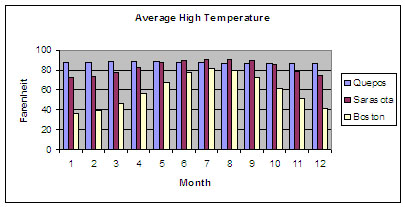 |
Average High Temperatures: Quepos = 87.1; Sarasota = 82.8; Boston = 59.3 |
|
Average Low Temperatures: Quepos = 70.2; Sarasota = 61.9; Boston = 44.6 |
|
Total Annual Rainfall: Quepos = 151; Sarasota = 54; Boston = 42 |
|
As one moves south from Boston through Sarasota to Costa Rica average temperatures get higher as expected but they also display less variation. Variation in statistics, you may recall, is measured by a term called "sigma" or standard deviation. Thanks to the power of Excel, standard deviations are easy to calculate from raw data such as that on the left. Remember also that + or - two sigma units predicts with 95% probability that data will occur within that range. Using two sigma variations the data tell us that, for monthly averages:
- For Quepos, the average high temperature will be (95% of the time) between 84.7 and 89.5 degrees Fahrenheit, rather narrow don't you think? For Sarasota, the range is 69.0-96.6 and for Boston the range is 27.6-91.0. Hey, beantowners, baked beans can freeze at some of those highs and the top number is higher than Costa Rica! You live with extremes, amigos.
- The low temperature range for Quepos is 68.2-72.2F (yes! only 2.5% of the time will the temperature drop below 68.2 (I love it here, amigos); for Sarasota the range is 45.3-78.5 and for Boston it is 12.8-76.4.
Of course another great difference is rainfall. For Quepos the average annual rainfall is 151 inches, a figure we've most likely already exceeded this year. For Sarasota the average annual rainfall is 54 inches and for Boston 42.
Also, there are some interesting anomalies in the data:
- The summers (June, July, August, September) are 3-5 degrees hotter in Sarasota than in Quepos.
- There is less rain on average in Costa Rica during January, February and March than in Sarasota or Boston. (OK now, we Ticos are in the extremes on this one)
- One should consider that a portion of the "rain" numbers for Boston in December through March need to be converted to inches of snow at the rate of 10 to 20 inches of snow per inch of rain, the low number being heavy, wet stuff and the higher being light, fluffy ski stuff.
Unfortunately, I was unable to get good comparative data on humidity but I expect Quepos and Sarasota to run roughly in parallel and considerably higher than Boston on average.
GG apologizes for the technical report but sometimes his engineering instincts get the best of him.
|
|
El Dia de Independencia
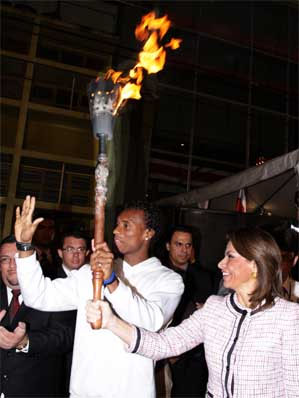
| A Torch is Carried From Guatemala (That's Our Laura, La Presidenta Helping Out) and Ends at Cartago, Costa Rica, the Seat of Power for Costa Rica When Independence Was Proclaimed From Spain. Many Citizens Carry Candle Torches the Evening Before Independence Day as Tradition Has It that the Document of Independence Was Signed in Cartago by Candlelight |
|
September 15 is Independence Day in Costa Rica and commemorates separation of the country from Spanish rule in 1821. In that year, the news of the joint declaration of independence that was declared in Guatemala by all the central american countries took a whole month to reach the Costa Rican people (it probably took another month after that to get to the Quepos area, which was accessible only by dirt path and which did not exist as a town at that time - more on that in a later issue). The first constitution of the country, which is not the present one, was soon adopted shortly after independence was declared.
The first European Spaniard to reach contemporary Costa Rica was an Italian,
Christopher Columbus in 1502 during his fourth and last visit to the new world. (Could it be that Chris was ready to chuck it all in and was looking for a retirement villa on the rich coast?)
During the next three centuries, the Spanish empire in the Americas came to be managed from three large centers; Mexico, Guatemala and Cartegena in Colombia. Costa Rica, like the rest of Central America, came under the auspices of Guatemala but Costa Rica was largely ignored because of its relatively small population and rugged trade routes which made routine communication difficult.
After independence from Spain there was a brief time (a dozen years or so) when Costa Rica was a state in the Federal Republic of Central America but the federation eventually disintegrated and Costa Rica declared its separate national sovereignty. It has been an independent nation ever since.
It wasn't until 1949 that the country had a real constitution. Up until that time it was governed and attempted to be governed by an assorted and sometimes sordid array of characters (William Walker, for example). The current constitution took effect after the civil war in 1948 and included the abolition of the military. For more on the Costa Rican constitution see, CR CONSTITUTION.
|
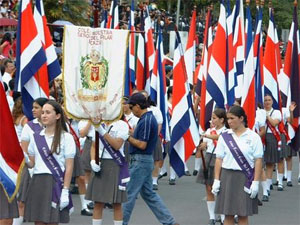
School Kids Showing Their Colors |
|
I must say that Ticos seem to celebrate and enjoy their Independence day as much as Gringos do theirs in the United States. And they don't appear to be as reticent about flying their flag as seems to be the case in recent years in the U.S.
The C. R. tri-color pops up virtually everywhere, on private vehicles, on buses, on private and public buildings on every surface that seems convenient. Parades and colorfully costumed dancers abound.
In gg's opinion, one of the most attractive parts of El Dia de Independencia is watching the kids. All ages are encouraged to participate and many dress up in beautiful costumes of red, white and blue as well as native dancing costumes. The smiles on the kids faces at this year's parade were incredible. |
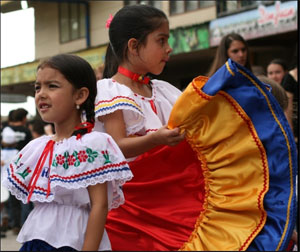
Felicidades y Pura Vida, Amigos! |
|
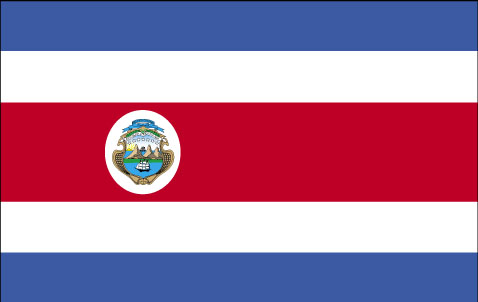
The National Flag of Costa rica |
|
Flag Description:
Five horizontal bands of blue (top), white, red (double width), white, and blue, with the coat of arms in a white elliptical disk toward the hoist side of the red band; Costa Rica retained the earlier blue-white-blue flag of Central America until 1848 when, in response to revolutionary activity in Europe, it was decided to incorporate the French colors into the national flag and a central red stripe was added; today the blue color is said to stand for the sky, opportunity, and perseverance, white denotes peace, happiness, and wisdom, while red represents the blood shed for freedom, as well as the generosity and vibrancy of the people.
|
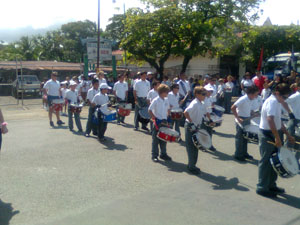
Quepos Parade - How the Boys Drum Corps Love to Beat Their Drums! |
|
|
What's-in-a-Name
The origin of surnames is always fascinating to me and the searching thereof now seems to be a subject of profit on the internet. But there are still, well, many free sites where last names can be investigated (read on to see how bad that segway was). I have a friend in Quepos with the last name "Stilwell" (he and his good works were featured in Episode 20). I was curious where the name came from so I went on the net and found this free site for checking names: http://www.surnamedb.com/. This is what I got on Stilwell:
"This interesting name is of Anglo-Saxon origin, and may be either a topographical or a locational surname, found mainly in the Southern counties of Hampshire (you know, like in ♫Hartford, Hereford and Hampshire Hurricanes Hardly Ever Happen♫) and Surrey. As a locational surname, Stillwell or Stilwell derives from a now "lost" place, one of the estimated seven to ten thousand English villages and hamlets known to have disappeared since the 12th Century. The main reasons for this were natural disasters such as the Black Death (plague) of 1348, in which an eighth of the population perished, and to the widespread practice of enforced "clearing" of large areas of land to create sheep pastures (baaaaad land policy amigos). The place is thought to have been situated in Surrey, and the name means "the fish-trap in the stream", derived from the Olde English pre 7th Century "stiell, staell", place for catching fish, and "well, waell", stream, spring, well. As a topographical surname, Stillwell denotes residence by such a place. The marriage of Arnold Stillwell and Mary Mills was recorded in Farnham, Surrey, on November 22nd 1568, and Frances, daughter of John Stilwell, was christened on January 6th 1623, at St. Giles' Cripplegate, London. The first recorded spelling of the family name is shown to be that of Elyzabeth Styllwell, which was dated April 14th 1542, christened at Headley, Hampshire, during the reign of King Henry VIII, known as "Good King Hal", 1509 - 1547. Surnames became necessary when governments introduced personal taxation (there they go again, amigos). In England this was known as Poll Tax. Throughout the centuries, surnames in every country have continued to 'develop' often leading to astonishing variants of the original spelling."
I wonder what the fish trap looked like - maybe a trot line? The early Stilwells were probably indispensable as a supplier of pescadoral products during the initial development of English fish & chips recipes (good show, gov).
Now, I had a brother-in-law once whose last name was Dupuis. I know that "puis" in French is a well; so his ancestors probably hung around the well a lot also. I have no idea how still there wells might have been (sorry, sometimes I just have to do it). It's interesting that the well was so important in early cultures that it carried forward in surnames (well, I think it's interesting anyway). I wonder if the Stilwells and Dupuis' ever got together at the annual IWDA meetings (International Well Diggers Association)?
And then, of course, there is gg's surname, "Normand", for which I got this explanation:
"This interesting name (I guess every name in this database is "interesteing") originated either as an ethnic byname for Scandinavian settlers in England, who came to be known as Northmen or Normen, from the Olde English "Northmann" (plural "Northmenn"), meaning "men from the North", or as a post - Conquest name for someone from Normandy in the North of France (my best information is that we came from this latter source as most of my ancestral relatives spoke French and the word-of-mouth was they settled in Quebec). The derivation in this case is from the Old French "Normand" or "Normant", a Norman. Many of these Normans were themselves originally of Scandinavian origin, which makes for an interesting re-introduction of the name into England. The personal byname Norman, with its Latinized form "Normannus", was recorded in the Domesday Book of 1086, and continued in popularity as a personal name throughout the subsequent Centuries. in the modern idiom the surname can be found spelt (sic) as Normand, Normant and Lenormand. The surname first emerges in the latter part of the 12th Century, (see below). Other early recordings include: John le Norman, (Warwickshire, 1221); Robert Northman, (Oxfordshire, 1279) and John Normand, (Roxburghshire, 1303). George Warde Norman, (1793 - 1882), a respected writer on finance , who was director of the Bank of England from 1821 - 1872 (probably the last Norman that made his finances work). The first recorded spelling of the family name is shown to be that of Hugo Norman, which was dated 1171, in the "Pipe Rolls of Wiltshire", during the reign of King Henry II, known as "The Builder of Churches", 1154 - 1189 (huh! we beat the Stilwells into jolly old England by six Henries).
So there you have it, while the Dupuis' and Stilwells were attending to community wells and catching fish, the Normans were out there raping, pillaging the countryside and messing with the banking system both in France and England. Come to think of it, I remember hearing family stories about my great, great grandfather continuing some of those practices after he landed in Quebec.
I suppose this is why the Normans are always so badly portrayed in stories like Robin Hood and Ivanhoe. Big deal. C'est domage, mes amis.
Miscellany
Double Humor
Siamese twins walk into a bar in Canada, and park themselves on a barstool. One of them says to the bartender, "Don't mind us; we're joined at the hip. I'm John, he's Jim. Two Molson Canadian beers, draft please." The bartender, feeling slightly awkward, tries to make polite conversation while pouring the beers. "Been on holiday yet, lads?"
"Off to England next month," says John. "We go to England every year, rent a car, and drive for miles. Don't we, Jim?" Jim agrees.
"Ah, England!" says the bartender. "Wonderful country. The history, the beer, the culture..." "Nah, we don't like that British crap," says John. "Hamburgers and Molson beer, that's us, eh Jim? And we can't stand the English - they're so
arrogant and rude."
"So why keep going to England?" asks the bartender.
"It's the only chance Jim gets to drive."
(from reader and contributing humor editor - Randy M.)
R.O.M.E.O. Corner (Retired Old Men Eating Out)
The ROMEO Corner was added to the Chronicles in February of 2010, which gives us nine reviews to date. To make it easier for readers to find back reviews, we have added a Restaurant Archives section, the link for which can be found next to the GGC Archives link at the bottom of the page. Buen Provecho, muchachos!
Sancho's
Location: Top of Manuel Antonio hill across the street from Barba Roja; Off-Street Parking: Take-Out
Hours: 10 AM to 10 PM Monday through Sunday
This is a new restaurant across the street from the Barba Roja (we must remember to make a ROMEO review visit to Barba Roja also - oh my, so many restaurants, so little time).
The store front at Sancho's is unassuming. Indeed, there are some rather fancy restaurants in Manuel Antonio and this isn't one of them but I'm sure it's by design. The entrance is below street level, like some Manhattan bistros. The dining room is simple, clean and sports only a pleasantly light touch of Mexican decorations (no large hats perched over crossed marachi's here). This is a neat cafe, pure and simple with a bus stop at the front door (very handy for a non-car owning ROMEO).
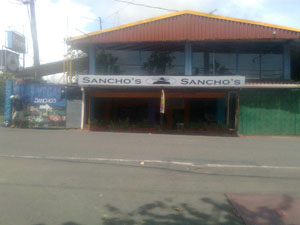
Sancho's Front Entrance - Manuel Antonio |
The proprietor of Sancho's is a pleasant gent named Marshall Watne. Marshall has owned and operated a small chain of similar restaurants in the Lake Tahoe area. It was evident from our visit that he has perfected his formula.
|
The fare is Mexican and I mean good Mexican, not a Tico version thereof nor one of those Gringoized near-Mexican types with refried beans that could better be used to set cement blocks. The beans here are red, tender and not mushy.
My partner ROMEO opted for the potato tacos which are only available on Wednesdays (as is the chicken, cheese or potato enchiladas; on Fridays, the special is home made tamales). Of course I also had to sample the tacos. We both went "yes!", the filling being so fresh and tasty. I had never had a taco with a mayonnaise-laced potato lining at the base. Yummy. The three tacos came with portions of rice and red beans virtually filling the plate.
I ordered something I had never seen on a menu: Sope. It's pictured at the right and consisted of a large, soft tart filled with shredded pork (you can choose either spiced or non-spiced meat; I opted for the latter), cheese, a few beans and topped with a very lightly spiced green salsa. Again, yummy.
I must admit I am not very knowledgeable when it comes to Mexican food as I pooh-poohed it for years because of the prejudicial reasons listed above (you know, refried bean cement). But eventually I got to sample better Mex fare such as "Ninfa's" in Houston and one or two places in San Diego. Sancho's quality is up there with the best I've encountered. |
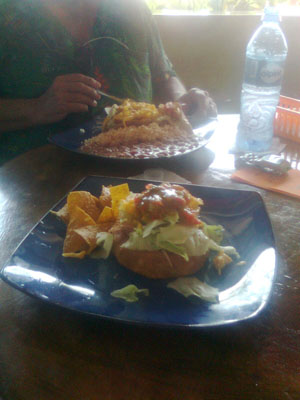
Potato Tacos in the Background, Sope in the Foreground |
|
After we had consumed our lunch with barely a hint of it remaining on our plates, we were in for another pleasant surprise, the bill was not at all overwhelming. Both of us got out of there for around 3,000 colones (OK, I'll give in this time for the Rio Lindans - that's about six bucks). Remember, this is Manuel Antonio where a breakfast or lunch rarely goes for less than 5,000 colones.
Sancho's is the kind of place that fits the bill for both area residents and tourists. We ROMEOS stopped there for lunch on the way back from our continuing duties as supervisors of Manuel Antonio beach. Sancho's is a great and easy stopping point when you're traversing the hill to or from the many natural and unnatural attractions on the Manuel Antonio mountain. The new restaurant is definitely a credit to the area.
We give Sancho's four sloths and an inexpensive dollar rating.
The Sloth Rating is for Ambiance, Food Quality and Service; Maximum 5. The Dollar Rating is for a Typical Meal in Comparison to Other Restaurants in the Area, 1 = inexpensive; 5 = expensive. |
|


|
Travel quote of the month:
"I travel not to go anywhere, but to go. I travel for travel's sake. The great affair is to move".
~ Robert Louis Stevenson
Don Roberto de Quepos,
El Gringo Dorado
Pura Vida! |
|
|

